Trending
Opinion: How will Project 2025 impact game developers?
The Heritage Foundation's manifesto for the possible next administration could do great harm to many, including large portions of the game development community.
It's the mobile game taking the world by storm! But is Pokémon GO a fad, or the start of a trend in the industry? This is a teardown and deconstruct of the core mechanics and where Niantic go from here.

In the rare case that you've been living under a rock for the last month, you'll be aware of the cultural phenomenon that is Pokémon GO! A cross between an augmented reality game and an alternate reality game developed by Niantic, published by The Pokémon Company and partially funded by Nintendo. At the time of writing it's the number one downloaded and top grossing game in both the USA and Japan, with only the Chinese market (where the game is not yet live) left to be conquered!
 Top downloaded and top grossing app in 2 of the 3 biggest digital mobile stores in the world. Truly incredible.
Top downloaded and top grossing app in 2 of the 3 biggest digital mobile stores in the world. Truly incredible.
This post covers a game teardown, some commentary on it's success and tries to look at if this type of game is a one-off or a game-changer in the mobile marketplace.
 Using real-world maps, players can discover Pokémon around them. Players then try to catch Augmented Reality versions of the monsters in real world surroundings using Pokeballs.
Using real-world maps, players can discover Pokémon around them. Players then try to catch Augmented Reality versions of the monsters in real world surroundings using Pokeballs.
In Pokémon Go, players take the role of a Pokémon Trainer whose goal is to collect a set of "Pocket Monsters" that can be discovered around the real world via the use of augmented reality. The game cleverly combines augmented reality to superimpose the cute monsters into real life surroundings and location based / alternate reality gaming techniques to make this gameplay fit into the real world. A more complete teardown can be found below, but it's important to point out the high-level goal and structure of the game to be able to dig in and understand it's success.
Disclaimer: I've been playing the game for a while now to get a thorough understanding of it, but reserve the right to edit this article as I learn more about it! The game a lot of hidden depth to it.
This title is fascinating because it brings back so many technologies and game ideas from the past, many of which were generally thought of as unviable. I think it's interesting to take a look back down memory lane at some ideas that have trail blazed the path for some of the success Pokémon GO.
 An example of an Augmented Reality app from IKEA which allows users to preview what their furniture line would look like in your own home.
An example of an Augmented Reality app from IKEA which allows users to preview what their furniture line would look like in your own home.
Augmented Reality as a technology has been around for a long time, placing virtual items into a real world (augmentation) on the fly and allowing the two to pseudo-interact with one another. It's been especially popular with companies trying to generate brand awareness through placing their products virtually into customers real world views. In fact Google once saw it as a huge part of their vision for the future with their Google Glass vision of propelling wearable computing into the mass market to advance on the role that modern smartphones have taken in consumer's day-to-day lives. In fact before the move to Virtual Reality that many industry observers are predicting over the next 5-10 years, AR was seen by many as a more likely step-change for computing. However, despite many offerings from developers around the world over a number of years, AR has never really caught the imagination of the mass market - until now. The success of PG means that the world of AR is likely to be revisited. Can you imagine a Google Glass version of Pokémon Go? With some Glass specific features or additions, it could be a killer app from day one!
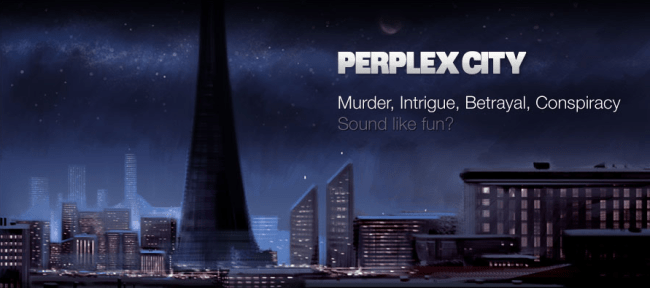 Perplex City was an alternate reality game developed by London-based developer Mind Candy. Players competed to find an "artifact" that had been placed somewhere in the world. Whoever found it first would receive a prize of £100K.
Perplex City was an alternate reality game developed by London-based developer Mind Candy. Players competed to find an "artifact" that had been placed somewhere in the world. Whoever found it first would receive a prize of £100K.
Alternate Reality and Location based games have also been around for a long time. Here in the UK, London-based Mind Candy created a game called Perplex City that merged the real world into a fantasy setting where players competed against one another to find clues to a mystery artifact that was hidden somewhere in the real world that was worth $100K to the person that found it first. The game monetized through selling cards that held clues to the location of the artifact that directed players to various real life websites, phone numbers and so on.
Location based games were seen as an area of huge growth potential, with even TV channels attempting to work it into new quiz shows so that TV audiences could interact and play along weekly along with real contestants. However, despite many attempts to make the concept work, it again didn't seem to have enough steam to reach a critical mass and fell out of flavor as being a growth area. These ideas were popular but required a critical mass to really work, and acquiring or interesting enough people to participate was a huge challenge.

Step forwards Ingress, a fairly obscure augmented reality / location based-game that would be the front-runner to Pokémon GO. Also developed by Niantic, the game seemed to be a way to gamify the crowd-sourcing of real life mapping data for Google. Released exclusively for Android in 2012 initially,
 Ingress gameplay in action, even back in 2012 Niantic were experimenting with merging the real-world and virtual worlds together.
Ingress gameplay in action, even back in 2012 Niantic were experimenting with merging the real-world and virtual worlds together.
I have to confess, I have only tried to play Ingress since finding out about Pokémon GO, so am far from an expert on the game and it's structure. But according to Wikipedia, "the gameplay consists of capturing "portals" at places of cultural significance, such as public art, landmarks, monuments, etc., and linking them to create virtual triangular "control fields" over geographical areas. Progress in the game is measured by the number of "mind units" (MUs) captured via such control fields, i.e. people nominally controlled by each faction." A lot of this gameplay carries over (albeit simplified somewhat) into Pokémon Go, but core similarities include choosing a faction to align with, and having to visit real life locations to make progress in the virtual game.
Interestingly, though never setting the world on fire in terms of DAU numbers or revenues, the technology and gameplay was enough to convince Google, The Pokémon company and Nintendo to invest a combined $30 million into the company into what would eventually become Pokémon GO. I guess the lesson to learn here is that having a "dry-run" to make a game without the pressure of a beloved IP behind your product is a great way to iron-out lots of kinks in technology and gamification before casting the net wide. Often when trying to do something very different and radical it can take a long time to achieve success so the fairly long-term view the company had (for the tech world at least) is interesting to see. I think their CEO John Hanke and his team deserve a huge amount of credit for creating both Ingres and Pokemon GO.
www.youtube.com%2Fwatch%3Fv%3DmToV0JNQ0bE" data-wpview-type="embedURL">
An intellectual property beloved the world over, Pokémon started off as a Game Boy game developed by Game Freak in 1996 (god this makes me feel old!). An absolute classic, this timeless game was an RPG that involved the player travelling around a fictional universe collecting, training and battling with Pocket Monsters they had to collect, nurture and develop. The gameplay is timeless, addictive and surprisingly deep and would go onto spawn not only additional games but the start of a huge brand with movies, toys a hit collectable card-game and a TV show watched around the world. In Japan they even have Pokémon Centres that are stores dedicated solely to Pokémon merchandise and apparel.
The game has predominantly always been a mobile game, albeit rarely moving onto mobile devices and staying on Nintendo owned proprietary hardware instead such as the Gameboy and Nintendo DS. The core game design for Pokémon was very well suited for mobile gaming in general as it had emphasis on battling against other players (pre-Internet this was much harder than it sounds), social (players had to find a player with a slightly different copy of the game to get the final Pokemon in the original game) and was well suited to session-based gaming through grind-heavy gameplay and exploration of well proportioned game areas. Like many Nintendo games, I feel that Pokémon is an absolute masterclass in game design and all game developers can learn an absolute ton in terms of how to create long-term progression systems and meaningful grinding from this game that is very relevant to modern F2P games that are popular today. Pokémon games have sold over 200 million physical copies over the last 20 years and it's estimated the games have grossed over $46 Billion, and you don't achieve that just through good luck.
It's also hard to underestimate the power and appeal of the brand. Brands tend to have a fad cycle where they are hugely popular for a few years, disappear of the planet for a while and then come back stronger through nostalgia and parents introducing the brand to their children. Great examples in recent times of this include Transformers, Teenage Mutant Turtles and to a lesser extent Star Wars. But Pokémon has arguably never gone out of the mainstream consciousness and with the arrival of Pokémon GO is about to transcend to even more ridiculous heights. It truly is a dream IP and I wonder if original concept creator Satoshi Tajiri could ever imagine the impact his idea would go onto have.
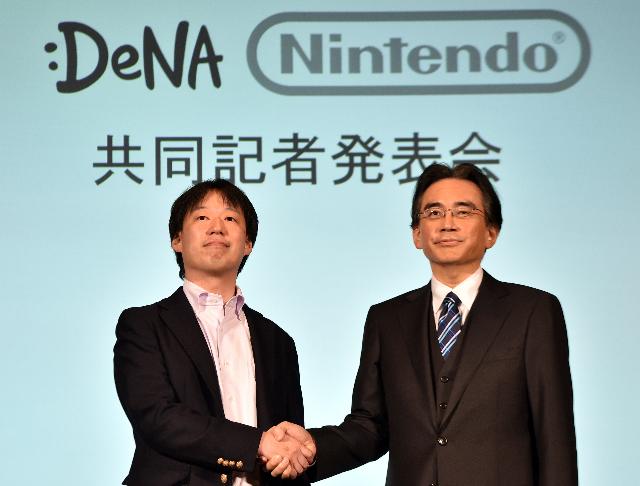 The then CEO of Nitnendo Satoru Iwata (RIP) on stage in 2014 to announce the partnership between Nintendo and DeNA and development of mobile applications and games for Smartphones.
The then CEO of Nitnendo Satoru Iwata (RIP) on stage in 2014 to announce the partnership between Nintendo and DeNA and development of mobile applications and games for Smartphones.
Nintendo is the oldest surviving gaming company on the planet. Originally founded in 1889 (!), they made the transition to video games in 1979 and have been responsible for creating some of the best games ever made. On a personal note, Shigeru Miyamoto is a personal hero of mine and possibly the best video game designer / producer of all time and his Nintendo games have generated insane amounts of revenue for the company. However, Nintendo as is the case for many large companies with a lot of history have not always been at the pinnacle of success. In fact they are very much a cyclical company who move between being at the top of the industry (Super NES era, Wii era) to being completely written off and "doomed" (Gamecube era, Wii-U era). In recent times they have been much maligned for not moving into mobile which is probably testament to their preference to monopolise and dominate via a platform-based model and ecosystem. I think Nintendo know they could easily create successful games on other platforms such as web or mobile, but have been hesitant to do so because they would prefer to be a platform owner. Remember that although Machine Zone might be making in excess of $3m a day through Mobile Strike and Game of War, Apple takes 30% of both of those games and every other game on the app store...
 Social Network / Game hybrid Miitomo was the first app developed by Nintendo exclusively for mobile.
Social Network / Game hybrid Miitomo was the first app developed by Nintendo exclusively for mobile.
In 2014, Nintendo announced they finally would be moving into mobile via a collaboration with Japanese mobile publisher DeNA. Results so far have been fairly slow, with Miitomo being the only app released so far. It's likely that Nintendo are taking their time to get things right and are also thinking carefully about their strategy on mobile in terms of their overall company strategy. Nintendo are set to launch a new hardware platform this year and it will be interesting to see how games and apps by them on mobile interact with the system. It is believed that games might be transferrable or interact with each other in some way and that the new platform may be a handheld device hybrid in itself. It will definitely be fascinating to see what the new system is, as Nintendo are one of the few companies that are capable of creating a huge market shift as evidenced with the Gameboy, Nintendo DS and Wii over the last 25 years.
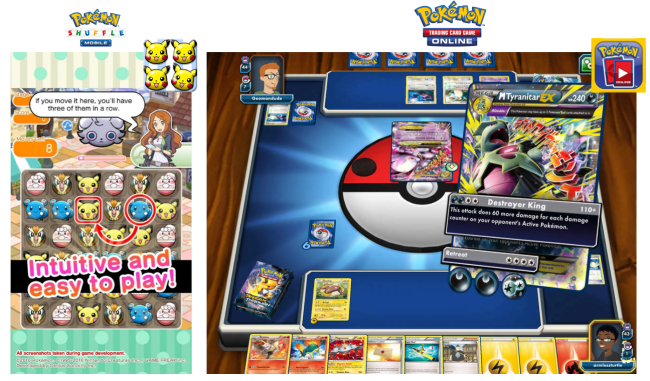 Two of the previous Pokémon games released on mobile so far, Pokémon Shuffle and Pokémon TCG Online.
Two of the previous Pokémon games released on mobile so far, Pokémon Shuffle and Pokémon TCG Online.
As for Pokémon, it's important to note that Pokmeon GO is not the first time the IP has appeared on mobile. The Pokémon Company has released a number of apps onto the store already, trying out some fairly conservative ideas with a variation on Japanese mega-hit Puzzle and Dragons in "Pokémon Shuffle" and a port of their incredibly successful Collectable Card Game "Pokémon TCG Online." Especially in the case of the TCG, I think it's fascinating to see that the game was a dud because it took a smash-hit known success (the card game) and moved it onto mobile taking cues from a game that did something very similar in Hearthstone. You could argue that of the 3 games they have made, Pokémon Go was by far the riskiest but yet the most successful by an insane amount. I personally think it means that although the Pokémon IP is one of the main reasons for the game's success that it also speaks to the execution of the game and it's concept in being a major strength in terms of creating such a huge reaction. I think it's really smart of The Pokémon Company to diversify their portfolio and to cover their bets by releasing a number of games ranging from safe to risky in an attempt to learn the market and see what does / doesn't work. Of course it helps if you have the kind of cash reserves that they have and the support of Nintendo!
Pokémon Go is a very interesting game to deconstruct. There are elements that I feel are absolute genius combined with elements that for me could be improved substantially. However, the overall package is great and if there is one thing that the game does better than maybe any game I've ever played, it's that of fulfilling a player fantasy. Like millions of people around the world, I watched the Pokémon TV show as a kid, played the games and dreamt of being Ash Katchem travelling across the world with Pikachu trying to become an elite Pokémon trainer. With this game, thanks to the use of the player's mobile device to act as a real-lie Pokedex I feel as if I AM Ash in real life. The execution of that fantasy is paramount because it means players use their own brains and imagination to imagine parts of the game that are not there.
It's similar to how a film adaptation of a book can do a good job in portraying an epic scene, but in that it can never truly do it justice, because the scene from a book in a reader's head will always be a thousand times more vivid and real because they have to engage their brain. When I am walking down the road and feel my phone vibrate because there is a rare Pokemon nearby, it fills you with a rush of excitement and adrenalin before even booting the game up! That feeling is something we should all try to aspire to do as game makers on mobile.
This game appears at first to be pretty simple but there is a lot of depth to the game that isn't immediately obvious.
 The core loop of Pokemon GO! Players exeprience this loop for the first couple of days in their Player Journey before discovering new ways to play.
The core loop of Pokemon GO! Players exeprience this loop for the first couple of days in their Player Journey before discovering new ways to play.
After going through a tutorial which involves creating a name and 3D Avatar, the core loop of the game asks players to travel around the real world using their phone to find Pokemon. The "GO" part of Pokemon GO supposedly stands for "Go Outside" and it certainly executes well on achieving this. The app uses Google APIs with Google Maps to create a quasi-3D view of the world around you as if it was part of the Pokemon world. Occasionally you will find a Pokemon on your journeys and tapping on the pokemon takes you to an encounter and a chance to capture it.
 Map View in Pokemon GO. Image taken from the Niantic website - https://support.pokemongo.nianticlabs.com/hc/en-us.
Map View in Pokemon GO. Image taken from the Niantic website - https://support.pokemongo.nianticlabs.com/hc/en-us.
Exploration is one of the game's key core mechanics and is in my opinion the true genius of the game. In console and PC RPG's, exploration is a huge part of the experience. Games such as Skyrim and World of Warcraft are believable worlds that players can spend hours if not days travelling across to find people, quests and things to do. Creating virtual worlds is a hard enough challenge by itself, but especially so on mobile. People in general don't have time to play for long sessions on a mobile device, so using heavy exploration can take players away from the core gameplay and can mean they feel lost when they return. However, cutting out these elements altogether (as most mobile RPG's do) means that the overall RPG experience loses some of the unique fun of the genre.
 Final Fantasy: Brave Exvius by Gumi / Alim takes the battle mechanics of Brave Frontier and adds more traditional RPG elements to it such as character interaction and exploration.
Final Fantasy: Brave Exvius by Gumi / Alim takes the battle mechanics of Brave Frontier and adds more traditional RPG elements to it such as character interaction and exploration.
Being a location based game, Pokemon Go uses the REAL world for players to explore, and goes with Nintendo's new company mission to make "Quality of Life" products. Quite simply the best way to progress in Pokemon Go is to go outside and start walking around! This means rather uniquely that players are effectively spending a hidden currency - their own real life stamina. From a personal example I can say that on one Saturday afternoon in 3 of London's main parks (Hyde Park, St. James Park and Regents Park) I saw literally hundreds of people walking around with their phone in hand trying to find Pokemon, a very real example of reaching critical mass and was truly amazing to see.
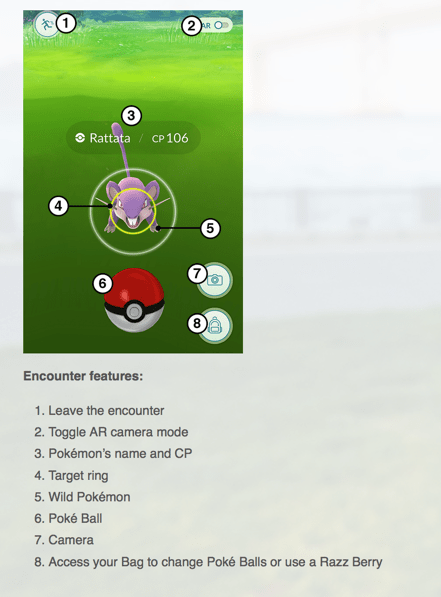 A wild Rattata appears in a Pokemon encounter! Image taken from the Niantic website.
A wild Rattata appears in a Pokemon encounter! Image taken from the Niantic website.
Once a player encounters a wild Pokemon, they then have a chance to capture it, an element taken directly from the original Gameboy games. However, this sees a fairly dramatic departure from the original game. In the mobile games, players had to battle enemy Pokemon to weaken them before using a Pokeball to capture them. In Pokemon GO the battle aspect is removed from the core loop and instead players engage in a mini-game where they have to aim and throw a Pokeball to hit the Pokemon they want to capture. Pokeballs are limited in number and are one of the primary monetisation mechanics in the game, although players get a refill of them whenever they level up.
In this micro mini-mechanic I feel Niantic have also found a true spark of genius in the game. The mechanic is fairly trivial, but is very tactile. There is a small skill based element that has a small chance of making a difference to the capture chance. You see just like the Gameboy game, you are not guaranteed to catch the Pokemon. Sometimes you might get a great shot and hit the Pokemon but it may escape. There are also small variances in throwing the Pokeball meaning that players can perform a "nice shot" or a "great shot." This means the game revolves around a very focussed mechanic that is simple to pick-up and play, but that has a level of mastery to it. It also means that there is a legitimate action in the game that is key to making the experience addicting to play. More on that later.
 Capturing a Pokemon adds it your collection and rewards the player with Stardust and Candy. There is a piece of Candy for each Pokemon in the game.
Capturing a Pokemon adds it your collection and rewards the player with Stardust and Candy. There is a piece of Candy for each Pokemon in the game.
Once the player captures a Pokemon it's added to their Pokedex, a mechanic taken from the original game and key to the Pokemon experience. Pokemon has had the brand statement "Gotta catch them all!" for as long as I can remember and is a memorable and fun way to describe the basic game. Fundamentally the game taps into our human desire to collect, and playing the game to collect all of the Pokemon is a deviously simple but addictive proposition for players to understand.
Capturing in Pokemon is actually a lot deeper experience that you might initially think. In many collection based games, a fundamental design problem to solve is that of duplicates. It's awesome to capture Pikachu, but do I really want to capture 100 Pikachu's? From a game design perspective the answer is probably yes because otherwise a player will burn through content quickly and the team would have to keep releasing new Pokemon to keep players invested in the game.
 After capturing a new Pokemon it's added to your Pokedex.
After capturing a new Pokemon it's added to your Pokedex.
Pokemon GO deals with duplicates in a number of ways. Behind the scenes there are some stats that players can't see that determine variability on Pokemon. Just because I captured Pikachu doesn't mean it's an optimal Pikachu. Just as in real life there might be variances between animals of the same breed (some Horses are faster than others, for example), variances also exist between Pokemon. So you might want to take time to find a better version of the one you already have as it might give you the edge in the Gym Loop part of the game.
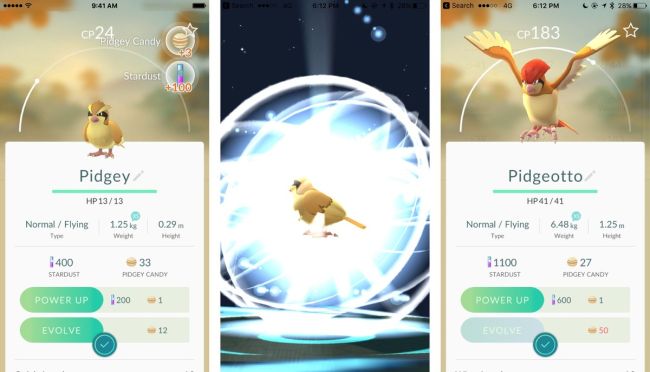 After collecting enough Pidgey Candy and Stardust, a player is able to Evolve him into the upgrading version Pidgeotto, who is more powerful and durable in battle.
After collecting enough Pidgey Candy and Stardust, a player is able to Evolve him into the upgrading version Pidgeotto, who is more powerful and durable in battle.
In addition to this, there is an even more fundamental reason to capture more Pokemon. Not only do you get Pokemon, you also get Stardust and Pokemon Candy. These are key currencies that are used to power-up your Pokemon to improve them for the Gym loop and used to evolve them into new Pokemon and more advanced types. An awesome mechanic that has been in every Pokemon game is that some Pokemon have to be evolved to reach a new state, meaning the player has to nurture and raise their Pokemon. To evolve Pikachu into Raichu, the player may have to capture many Pikachu to get enough candy to be able to evolve him. This means that the player is incentivized to keep collecting them and keep playing.
 Levelling up in Pokemon GO earns new items that can be used to help progress.
Levelling up in Pokemon GO earns new items that can be used to help progress.
Capturing more Pokemon earns XP which helps the player level-up to progress (we all like seeing numbers increase!) as well as acquiring new items such as Pokeballs and items to help catch additional Pokemon. Though this core loop is consistent through a player's journey in Pokemon GO, as they get progress through the game there are additional hoops to jump through to get rare Pokemon. For these Pokemon, players have to use new mechanics such as improved Pokeballs, Lures and Eggs. More on Eggs later.
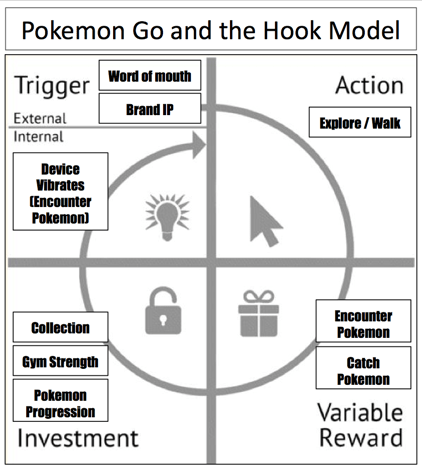
If you're interested in making mobile games and apps, I highly recommend checking out Nir Eyal's Hook Model and think about it's relevance to the most popular apps and games in the market. He describes a model that can be applied to a number of hit apps that can help explain their success. In laymans terms, apps that see the most use in people's lives are those that are addictive and that trigger players into returning to them over and over. Whether intentional or not, Pokemon GO fits into this model incredibly well and I think is one of the reasons why it's so addictive and successful. Players first get into the game by buying into the hype (like reading this blog!), from hearing about the game word of mouth of from general interest from the global IP that is Pokemon.
Once in, the game has two very simple actions (walking and the capture mini-game) that sometimes result in a variable reward - a Pokemon. That Pokemon could be of a certain power or rarity, or it could be a Pokemon that you already have but a stronger version. Trying to capture or encounter is in itself variable, you aren't always guaranteed the thing you want or that the capture will be a success, so the chance of finding and capturing in itself is an addictive experience that promotes returning to the game.
Once Pokemon have been captured, it adds to the sense of investment. Inside the core loop, collecting more creatures, increasing their strength and increasing your player level is a great sense of progression, with the Gym loop adding another social layer to this in the mid and elder game.
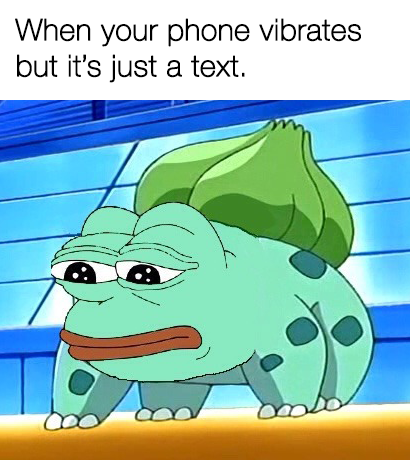 Once your addicted to Pokemon GO, the above picture will almost certainly apply to you.
Once your addicted to Pokemon GO, the above picture will almost certainly apply to you.
Finally, to complete the cycle the game has great ways to bring you back into the game. If you are walking along and feel your device vibrate, it can mean only one thing! A Pokemon is nearby! This gets your Adrenalin going and the excitement rush as you pull your phone out to see what you have found. What I find crazy about the app (as it stands) is that it does not send you local or Push notifications, you have to keep the game running to get these notifications. I feel that a small optimisation would be to send you notifications (in the way that Google Maps does) and this would result in people opening the app even more often they already do!
If you combine all of these elements you get a super addictive app and experience that pulls you back into the game for a long time. It's a brilliant execution of the Hook Model.
 A simplification of the Pokestop / Hatch "loop" in Pokemon GO.
A simplification of the Pokestop / Hatch "loop" in Pokemon GO.
The core loop of Pokemon GO is really well designed, but there are other sub-loops that the player can go through that add a missing ingredient - social. The first of these is the Pokestop functionality in the game.
 A simplified explanation of Pokestops in Pokemon GO.
A simplified explanation of Pokestops in Pokemon GO.
Pokestops are places of interest in real life that can be found in both the Pokemon and real worlds. An example might be "Oscar Wilde's house sign" in West London, that might be somewhat hidden way but interesting to see. When the player discovers one of these stops, they can spin it on the real map to claim rewards that will help them progress. As an additional step, players may occasionally find Eggs from Pokestops that can hatch into rare Pokemon. In order to hatch an egg, players have to walk for pre-defined distance (up to 10KM!) with their device on them, measuring the distance via GPS. Some people have tried to cheat this system by traveling in a car or on a bus, but the app is smart enough to detect when this is happening meaning that players have to perform physical exercise to hatch these eggs. It's a genius idea that is really well executed and also fits into Nintendo's "Quality of Life" mission statement.
 A Pokemon Go egg hatches!
A Pokemon Go egg hatches!
Pokestops benefit the player by visiting them, but to make even more use of them, Pokestops can be used socially with Lures and co-operating with others. As players advance into the mid and elder game, they can use Lures at Pokestops to increase the chances of rare Pokemon appearing. Multiple players can visit the same Pokestop at once and combine Lure modules, Lucky eggs and so on to maxmise these chances even further. This means that co-operation and meeting up together is of high value and encourages real-world social instead of just virtual social such as in-game chat.
 Lure modules can be used with friends to maximise the chances to get great items and Pokemon.
Lure modules can be used with friends to maximise the chances to get great items and Pokemon.
I don't think these mechanics are very well on-boarded, but may well be part of the depth of the game and to spread word-of-mouth. It's a tricky thing to get right, especially on mobile, but having deeper elements of the game that aren't obvious and require players to figure out together can be great for long-term retention. The feeling of "working out" a game or beating the developer can be really rewarding, especially if it results in an advantage over other players.
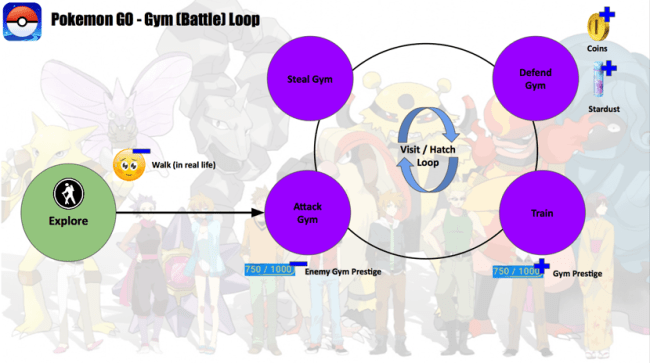 A simplified look at the Gym Loop in the game.
A simplified look at the Gym Loop in the game.
Finally we have the Gym loop, which is effectively the "Guild" section of Pokemon GO. This is something that isn't really advertised with the game and is actually quite unique for a Pokemon (or even Nintendo) game. This is the true elder game and where Niantic's MMO roots are most obvious to see. They use some pretty old-school Guild based gameplay mechanics and features simplified down to create a sense of social via reciprocation, the sense of fitting-in and good old peer-pressure.
 A quick look at Gym Battles.
A quick look at Gym Battles.
Unlocked after a few days of play, Gyms are persistent bases in the real world that can be held by Teams. There are 3 teams in the game, and the player chooses one of these teams to rally behind. Once found on the map, players can visit these Gyms to either attack, defend or train at, depending on their current status. If the Gym is currently held by an enemy, the player can opt to attack it, setting up a 6 vs 6 battle.
 Win battles and earn Prestige. But watch out for the enemy Pokemon type and their special moves!
Win battles and earn Prestige. But watch out for the enemy Pokemon type and their special moves!
Battles in the game feel familiar to battles in the Gameboy games, but are again simplified and are more tactile. Players tap the screens to perform attacks, and can dodge enemy attacks by swiping left and right at the right time. They can also hold the screen down to unleash a special attack if their Pokemon has one. A big change for the series is that battles are real-time as opposed to turn-based, probably in an attempt to keep the game flow fast so that battles can be resolved quickly compared to the console games.
Battles are made to be pick up and play, but again have a surprising amount of depth to them. Just like the console games, there is an RPS system at play with some Pokemon stronger against others. Thus players should think about the best Pokemon to bring with them to defeat an enemy gym. In battle, each Pokemon has "tells" meaning it's possible to dodge an enemy attack if you know what to look out for. Probably the biggest difference is that battles are asynchronous compared to synchronous in the Gameboy games which works better for a location-based game like this one.
Gyms have a HP which is reflected in Prestige points. Defeating an enemy Gym whittles down some of their Prestige, whereas losing increases it. It means that in order to take down an enemy Gym, players have to attack it multiple times and may have to work together with friends to do so. Only when it's reduced to zero PP can it be claimed by an enemy team. If you lose a Gym battle your Pokemon can be knocked out and will need to be revived. Players can also find revive potions in the game which can be used to shortcut this process to keep going or can by them. This is actually a surprisingly harsh feature of the game, but only really happens in the Gym loop so only affects a smaller proportion of the playing base.
Once a Gym has been taken, it can be defended by 6 Pokemon, but in a great twist, only one trainer can add one Pokemon to the Gym. That means that to maximise the defence, 6 players must visit the gym and add a Pokemon there. Defending a Gym grants coins and bonus items every day, so there is a huge incentive to do so. It also really rewards players for social collaboration and working together, and harmonizes with the rest of the core loops. Find the best Pokemon, train them and evolve them, then add them to Gyms as part of your team's strategy. These are the types of mechanics that we find in Midcore Strategy games such as Game of War, Clash of Clans, etc but proves that they can be applied to many different games and genre types. This loop might only interest a small percentage of the overall DAU base, but I bet these are the most engaged and highest spending players.
Players also have an incentive to visit Gyms frequently. You can visit them and train your Pokemon by fighting a friendly battle against the Pokemon that are defending there. Beating them earns XP for your Pokemon which helps them level up and become stronger. It means there is real value in playing the loop multiple times and revisiting old locations to keep your Guild progression in the game going.
 The birth of this gentleman's first child wasn't enough to stop him from attempting to capture a wild Pidgey. I wouldn't like to be in this guy's shoes when his wife found out!
The birth of this gentleman's first child wasn't enough to stop him from attempting to capture a wild Pidgey. I wouldn't like to be in this guy's shoes when his wife found out!
Without doubt one of the things this game will be famous for is it's ability to go viral. Because Pokemon appear in real life situations, it can lead to some absolutely hilarious screenshots that are click-bait on Facebook and for all Internet media. The really interesting thing about this is that it's happened without having a share or tweet button integrated in-game. This is most likely due to the developers close ties with Google but also because the young demographic for whom the game can appeal to (part of the magic of Pokemon is that appeals to everyone!) might result in kids making fake Facebook and Twitter accounts that could lead to trouble from dangerous individuals.
It's really tough to come up with a feature set and game design that can help propel a game or app to make it go viral. Often it can feel like a waste of time developing features like this if they aren't used. However, in a game that is well designed with a game that is unique and impressive it can be an added X-Factor. Given the expense of acquiring players, anything that can be done to get people into your game is a plus. There is no way for a developer to know how many players have come into their game because of pictures shared on Facebook / Instagram / newspaper articles, but it's probably a huge number.
It probably goes without saying that I am a huge fan of this game. The biggest compliment I can give Niantic is that it feels like a Nintendo made game. Perhaps not so much with overall presentation and usability, which lack the charm of a typical Nintendo title but the design of the game which is easy to learn but difficult to master and with unexpected depth is classic Nintendo.
I found the overall depth of Pokemon GO to be a pleasant surprise. What appears from the outset to be a fairly simple game actually has a ton of depth to it with evergreen loops via it's Gym loop and interactions. There are also a ton of other subtle mechanics in the game that I haven't had the opportunity to touch on in this article that again add to it's depth. I think the key lesson here is to really think about both depth and progression systems in games. These are really important because although they might only touch a small percentage of the overall funnel of players that play a game, they are the things that can keep players playing for years. It's a real challenge and I recommend playing Asian mobile and console RPG games and trying to deconstruct them mentally to get good practice of how to build such systems. It's difficult!
I also appreciate the synergy of the game loops. The more you engage in the core loop, the more it helps you in it's other loops. The core loop is easy to understand, simple to play and crazily addictive. I feel like some good design decisions were taken to keep the core fun of Pokemon games and how to transition them to mobile. This game could easily have been far more battle focused, but moving that out of the primary loop, they have a game that is much easier to hit the critical mass.
Finally the thing that impresses me most about the game is how it really does (a) make you want to go outside and walk around and (b) meet-up with other people to share tips and work together. These are things that can help games become even more acceptable and mainstream and can help push the medium forwards. It's often said that mobile games haven't yet unlocked even 5% of the true potential of the mobile platform and what can be done with smartphones and I feel that Pokemon GO is a real step in the direction of more innovation and evolution in the marketplace.
 When making F2P games, something designers must closely monitor is the rate of progression amongst players. How long does it take to complete the game? Well one player has already done it! (Image from Kotaku).
When making F2P games, something designers must closely monitor is the rate of progression amongst players. How long does it take to complete the game? Well one player has already done it! (Image from Kotaku).
So although being a huge fan and advocate for this game, I feel like there are still a number of problem areas or improvements that could be addressed. There are already a number of planned updates which may well address some of these issues, but here's my attempt to offer some suggestions on what to improve.
It's often been said that retention is the most important metric for free apps. With there being so much choice on the app store, once you get a player in, keeping them is paramount. Pokemon has a LOT more depth and content that you might think, but there are already cases of players collecting everything. What is left for them to do next?
Usually game developers solve this in 3 ways. The first is the "content treadmill" of adding new content using the existing structure to players. Whilst Pokemon GO has 142 Pokemon, but there are actually over 700 if you include all of the franchises together. So by releasing a new batch of 50 or son in drips over the next few months, Niantic has ways to keep players invested. However, it does have a limited path and it makes you wonder why there aren't "Golden" or "Shiny" Pokemon in the game that would mean that super elder game players would have a reason to collect their entire set again just to get a Golden version of each Pokemon. This would be a really cheap way to increase the content massively.
 Puzzle and Dragons famously runs many events such as Dungeon challenges that are only available for a limited time.
Puzzle and Dragons famously runs many events such as Dungeon challenges that are only available for a limited time.
A different way to keep players invested is via Live-ops and events. Asian games in particular are famous for running events almost daily which offer the player unique challenges and rewards. This makes games feel fresh as there are always things going on and provide a ton of mastery potential for elder game players. Pokemon GO could easily run daily events such as "Collect 50 Pidgey's today to earn a unique reward" and I'd be certain that engagement would increase massively and reactivate lapsed players.
That said I would be shocked if at some point we don't see some kind of Pokemon flash-mob style mechanic in the game. Imagine if a super legendary Pokemon appeared in a rare location that required 20K people to show up to defeat it and capture it... I am pretty sure 5 times that number would show up to do it!
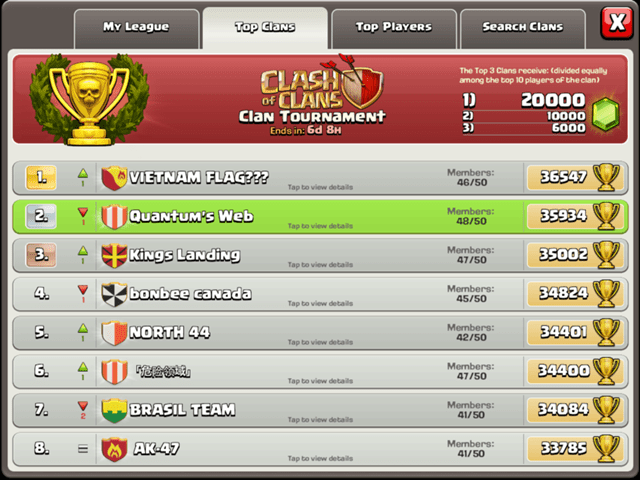 Clash of Clans have tournaments and leaderboards available regularly in seasons. These keep players competing in an evergreen way.
Clash of Clans have tournaments and leaderboards available regularly in seasons. These keep players competing in an evergreen way.
The final way (and probably the best way in terms of ROI) is through evergreen gameplay. Through leaderboards and seasons, players can battle forever if they enjoy the base gameplay enough. Pokemon already has Gyms and Battles, but I feel it does a very bad job of making this matter. Global leaderboards to show which team is winning with rewards for everyone that takes part as well as rewards for the winning team would make the game even more engaging and would make players battle each other infinitely. Systems like these are brilliant because it means you don't have to keep pushing new content and changes and can focus on the core gameplay. Make that fun and addictive and these systems can people interested for years.
Pokemon GO starts off really strong with the ability to progress quickly and unlock lots of new and interesting things to do. However, after a while the game does become a huge grind that is very hard work and unrewarding. After a while, you seem to run out of Pokemon to collect and it's not obvious what you should do next to get them. Perhaps having a heat-map to show where people have found them or a global message board (if chat is not allowed) would help?
It also does not help that when you run our of Pokemon to collect, the progression through Gyms can be very slow. Invariably you bump into very high Combat Point (CP) values on enemy Pokemon that make it very hard for you to beat them. It creates a catch-22 where your Pokemon aren't good enough to beat other people but it's hard to raise their level quickly to be able to keep up.
However, both of these issues seem like in-game tuning and economy variables that could be tuned on the fly. It probably makes sense as the game releases to be a bit harsh on progression to make sure people don't blow through it straight away. As more and more updates are released, this could be re-tuned to remedy the problem.
 Chris Furniss suggests some ways to make navigation in Pokemon GO easier to digest.
Chris Furniss suggests some ways to make navigation in Pokemon GO easier to digest.
This might be fairly subjective given how many people are playing the game, but I don't think the game is as accessible or intuitive as it could be. I think this article by Chris Furniss does a better job of explaining some of the UX challenges the game faces far better than I can, but in a nutshell there are many abstract parts of the game that are hard to understand. It took me quite a while to truly understand the value of both Gyms and Pokestops for example.
I do appreciate there is merit from hiding some parts of the game to players. Part of the surprise and delight (certainly for Nintendo games) is working out things by yourself. The Mario Brothers series on the NES and SNES are great examples of slowly introducing new mechanics and power-up to the game whilst increasing the difficulty level so that when you go back and replay the game you can find things that you didn't know existed before. That is a real art in video games (including mobile) and it's something that if executed well adds to the overall experience. Overall though I feel that GO could do a better job making core game concepts more obvious and easy to understand to players.
Some of the staff at Niantic have a background in creating MMO's, and some of that Guild design can definitely be seen in Pokemon GO. However, I feel this is a huge growth area for the game in terms of improvement. First there are only 3 teams a player can join, this is great but it would be even more amazing if I could setup my own Guild within that team of 50-100 players in the way Clans operate in Clash of Clans or Alliances work in Game of War. This would make supporting and protecting Gyms much more personal and meaningful, instead of working with people who may be complete strangers. I could probably write an entire post around killer alliance / guild features and design, if done well it can really improve the long term stickiness of players in a game.
Speaking of strangers, it's interesting that Pokemon GO does not have any accompanying Chat, given that this was in the original Ingress game. It's most likely because Pokemon is an IP that is of great appeal to children and with a game that involves meeting up together, having chat could cause a HUGE problem if meeting up was facilitated by the game itself in the wrong hands. However, I guess that for other games that are more adult themed that are looking to take a leaf out of Pokemon's books, this would be an obvious addition to the game. Of course it would be awesome if working as part of my 50 man Gym team we could chat together and plan our attacks together. "Hey Matt let's go to Camden gym today to level up our Squirtles so we can help defend the Covent Garden Gym!" is exactly the sort of gameplay that leads to super-deep retention in Guild based games.
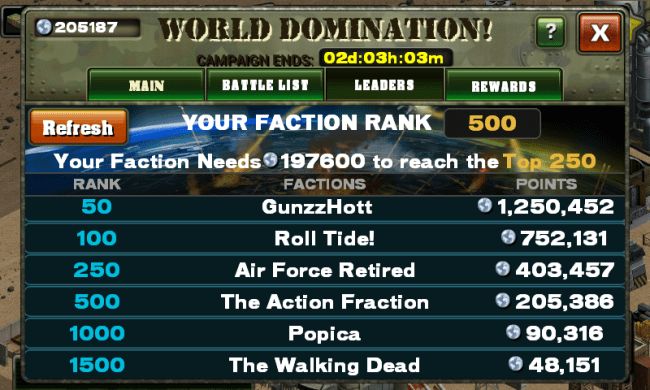 World Domination events that are run in GREE games are some of the best designed Guild events in mobile gaming even today. Choose a faction, work together and succeed by collaboration.
World Domination events that are run in GREE games are some of the best designed Guild events in mobile gaming even today. Choose a faction, work together and succeed by collaboration.
Alliance dynamics can also fit into live op events that are alliance based. GREE often run an event type called "World Domination" where players choose a faction and battle with and against other players around the world for a prize. Imagine if the only way to get a new Pokemon was to be part of the winning team over a week long event. It would really encourage people to work together for a common goal and would make people visit Pokestops and Gyms even more often.
 The console game series Dark Souls by FROM Software has an awesome note leaving mechanic that would work really well in Pokemon Go. However, maybe messages like the one above show why it's NOT in the game!
The console game series Dark Souls by FROM Software has an awesome note leaving mechanic that would work really well in Pokemon Go. However, maybe messages like the one above show why it's NOT in the game!
Somewhat related to Alliance dynamics are better social features. I would love to be able to put a pin on the map for my real friends that tells them where to go to get a specific Pokemon, especially if I have just found a rare one. It would also be awesome to put rallying flags on the map too in conjunction with beamed PN messages to my friends and team members "Blue team attack Yellow Gym at 17:00 today!"
 In the original Pokemon games on the Gameboy some Pokemon such as Arbok were only available in one version (in this case Pokemon Red). It meant to complete your Pokedex, you had to find a player with the other version of the game and trade!
In the original Pokemon games on the Gameboy some Pokemon such as Arbok were only available in one version (in this case Pokemon Red). It meant to complete your Pokedex, you had to find a player with the other version of the game and trade!
It's also surprising to see that Trading is not yet in the game. This has been confirmed as being in a future update, but the ability to trade unwanted Pokemon and items with each other is a great social mechanic that promotes collaboration. It was also one of the strongest and most unique features of the original Gameboy games, players had to trade to get certain Pokemon. Imagine if in Pokemon GO some Pokemon only spawned in certain cities or countries. Players around the world would have to work together to complete their collections!
Trading can be really bad for monetisation as it can short-cut spend, but in a game that goes wide on scale in terms of deep for monetisation, it's not really a problem and is a brilliant mechanic for expanding social and getting people to collaborate together.
Another surprising miss is that I don't a have a friends list of people I know / have met and am not able to compare my collection to others. Surely the point of this game is to race against other people to catch all of the Pokemon so not being able to do so feels a bit strange.
One other big surprise with this game is there is no direct PvP against other players. I suspect the main reason for this is because that is being held back for the new Nintendo system and "core" Pokemon game on that device. If it was possible to do that on mobile it might really impact those device sales even if it did mean better metrics and monetisation in the mobile game. It definitely feels like the most missing piece in the game currently as after making my team of Pokemon and investing time in them I'd love to be able to battle my friends in real-time PvP when sitting next to each other after meeting up at a Pokestop.
Something that I find fascinating as an outside observer is the monetization model used in Pokémon Go and by Nintendo in general. Before he passed away, Satoru Iwata made some fascinating remarks on the mobile industry and how Nintendo planned to approach it:
"My understanding of how to succeed in the Japanese market now is to find a limited number of generous consumers who are willing to spend a lot and analyze what encourages them to spend. However, if we did that, I don't think that we would be able to entertain hundreds of millions of consumers all around the world or to produce large and long-lasting achievements." - Satoru Iwata, Nintendo Investor Relations Q&A.
Essentially making money on mobile can vary between two bands. Casting the net far and wide to get as many players as possible and monetizing by a small amount from each player like Candy Crush or going after a fairly small subset of players and monetizing off them heavily such as Game of War / Mobile Strike. Both are successful strategies and both actually have the same downfall - user acquisition. An estimated 4000 apps a week are released onto the Apple App Store and the Google Play Store and to get people to download and stick to playing YOUR game is a brutal market to be involved in. Because of the strength of Nintendo's own IP's they have a huge advantage in mobile because they will be able to acquire players for very little money. In fact Pokémon Go has not had any marketing thrown behind it whatsoever, which when compared to the hundreds of millions of dollars that other companies have to spend is a very enviable position to be in.
 A list of items the player can buy from the shop in Pokémon Go.
A list of items the player can buy from the shop in Pokémon Go.
Pokémon Go has an almost negligible monetization model. The game utilizes soft currency only and the player can only buy additional coins which they get for playing the game and going through it's core loop anyway. Essentially they only monetize through minor impatience and do not use F2P favourites such as energy mechanics, Gacha or sales to generate revenue. They don't offer character skins or customization options and do not allow players to directly purchase Pokémon. They HAVE to play the game and engage to get everything it has to offer. Perfect for retaining players for a lengthy period of time.
 To celebrate the launch of Pokémon Go in Japan, McDonalds are turning all of their branches nationwide into either Pokestops or Gyms.
To celebrate the launch of Pokémon Go in Japan, McDonalds are turning all of their branches nationwide into either Pokestops or Gyms.
A classic way to monetize in mobile games that have critical mass but low monetization is to run adverts with the app. Having a huge DAU can mean the small number of clicks per user quickly add up and can generate into some serious eyeballs for advertisers who want to create awareness of their products. Pokémon Go currently does not offer any adverts, but I can certainly see them either adding them in or more likely cross-promoting other Pokémon and Nintendo content. It's wouldn't surprise me if a new console game is in development for the new Nintendo hardware out later this year that ties in heavily to the Pokémon Go app. And when that game comes out, I am sure the app won't be shy in reminding it's audience that it's available.
 A Pokémon Centre in Tokyo, Japan. If you are Pokémon fan, this place is unbelievably even more awesome than it already looks in this picture.
A Pokémon Centre in Tokyo, Japan. If you are Pokémon fan, this place is unbelievably even more awesome than it already looks in this picture.
Potentially an even more lucrative source of revenue may be derived from sponsorship. Because it's a location based game, Pokémon Go has the power to make people visit specific locations en masse with ease. As a colleague recently told me "imagine how many people are going to visit McDonalds in Japan for a chance to get the Pokémon they need to complete their collection whilst the tie-in is active!?" And of course whilst they are there battling to get their monsters, why not grab a quick bite to eat and drink at a very reasonable price...? I think it's safe to say that McDonalds likely paid a fairly large amount of money for the tie-in and it's also pretty likely it has turned out to be a great investment for them. This potentially opens up a whole new monetization model for all mobile games and that is a VERY exciting development for the industry.
 A comparison of Google searches between "Pokémon" and "Brexit." The British Exit from the European Union is a potentially catastrophic global event that could devalue economies around the world and see long-term recession and austerity measures for many. But it's no Pokémon...
A comparison of Google searches between "Pokémon" and "Brexit." The British Exit from the European Union is a potentially catastrophic global event that could devalue economies around the world and see long-term recession and austerity measures for many. But it's no Pokémon...
Further to new developments and tie-ins with third-parties, don't forget that Pokémon is already a very successful IP and has a ton of already available merchandise. I would frankly be shocked if you can get a ticket for their next movie for the first 3 months of it's release given the attention the brand is receiving right now. Keeping a successful and beloved brand in the public eye creates a positive feedback loop that drives sales and word of mouth in equal measure. It's why companies like Coca-Cola spend so much on advertising every year despite their basic product never really changing. And if Pokémon Go could retain it's current levels of adoption, it's value as a brand awareness platform would likely put it akin to something like a TV advert during half time of the FIFA World Cup Final in terms of reach.
Fad or the Future?
 Stock Prices for Nintendo have sky-rocketed after the debut of Pokémon Go.
Stock Prices for Nintendo have sky-rocketed after the debut of Pokémon Go.
So to answer the question that I asked at the start of this article - is Pokemon Go a fad, or here to stay? Like a true fence-sitter I think the answer lies somewhere in-between. The stock market certainly thinks highly of the product with the realization that Nintendo now has proven ability to turn it's IP into revenue on mobile even if it's just for the short-term. It can take a long time to truly adapt to a new platform and marketplace so these results so early mean that the inevitable Animal Crossing, Zelda and (dare I say this) Mario games for mobile have huge upside potential.
As for PG, it's unlikely to maintain it's currently level of adoption because quite simply there is no way the entire world can keep playing the same thing for so long. To put it into contest a full week before the game was available in the UK, I had a number of tourists from abroad approach me in the street to ask me where to get certain Pokémon despite speaking almost no English. If that isn't the definition of a cultural phenomenon, then I don't know what is! Depending on what ARPDAU the game has, that likely means that once "the next best thing" is available, not nearly as many players will play. Some players have already finished the game, meaning that it does have a shelf-life (although this could be remedied fairly easily). However, even after the "fad" phase passes, if the game can still retain the sorts of numbers that DAU heavy games such as Candy Crush and Clash of Clans have, then I see no reason why the game cannot continue to be a top-10 grossing game for a long-time. It really depends on the games Product Roadmap, Liveops and tie-ins and cross-overs with other Nintendo products. The potential is most definitely there!
In terms of this creating a market shift with ARG / location-based games taking over, I can't see that happening. As many people point out it took a HUGE brand like Pokemon to pull this off with the company's previous game Ingress (which arguably has more features) pailing in comparison. However, I could see copycat or imitator games from other IPs. I could imagine a Game of Thrones style game where players chose a House (e.g. House Stark) and have to defend "Castles" or a Star Wars game where players choose to fight for either the Light or Dark Side and have to battle with ARG Lightsabers... Hmm maybe I should get on the phone to some people...
My closing thoughts are as follows. This is truly a revolutionary game and although it took a monster IP to reach critical mass, there is some true genius in the app and game design that make it super addictive and FUN. It takes some great elements from MMO's and Alliance based games and appends it onto simple core mechanics that make people want to keep playing. It has the power to bring people together from all ages and get them out of the house and walking around, something no game has ever done before. The ARG is basically a gimmick and it won't be the new dawn of ARG that means VR is kicked down the road, but it's made it's impact and is probably going to stay around for a while. It's the location-based gaming features that I think are the real stand-out with this game and could be the secret sauce that does end up being replicated. We shall see!
Read more about:
BlogsYou May Also Like